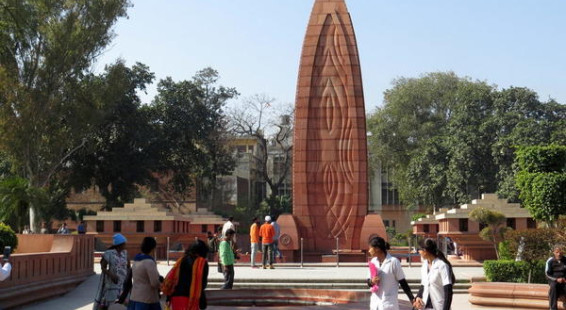
Jallianwala Bagh is a public garden of about 6.5 acres which is approached through a narrow walkway. Here you’ll find assorted monuments and memorials to a tragic event, a sad episode while under British rule. The events of this day were among those that began India’s march to independence.
On April 13, 1919 (which happened to be ‘Baisakhi’, one of Punjab’s largest religious festivals) thousands of people gathered at the Jallianwala Bagh to peacefully and non-violently protest the arrest of two community leaders, despite a curfew being in effect. On the order of General Reginald Dyer (who later claimed he was facing a revolutionary army), and without any warning, 50 British troops fired about 1650 rounds on the crowd for ten minutes until their ammunition was almost exhausted (the troops then withdrew from the site). The official (British) death toll was said to 379 residents, but civilian estimates range from 1000 – 1500 people killed and hundreds more wounded. No British soldiers were injured (The British version of the story is a little different than the one I share here, which is the story that permeates the site and which I tend to believe).

Entry to Jallianwala Bagh was limited to one main walkway as the garden was bounded on all sides by houses and buildings. A few smaller side entrances existed but most of these were locked. At the time of the massacre, the main entrance was guarded by the troops with armored vehicles outside, so people really had no where to escape to and no way to defend themselves. It must have been terrifying — being fired upon with no where to escape and no way to defend yourself against those firing at you.
When you visit today, mostly you’ll see a pleasant and nicely maintained, peaceful garden with the story of the massacre highlighted throughout the site. Even some of the vegetation is pruned to look like soldiers firing their weapons. You’ll find walls around the garden that still bear bullet holes from that tragic day.

Martyr’s Well, Jallianwala Bagh
It was a sad day in many ways, but none more so than at the well (Martyr’s Well) on the site. 120 bodies (including women and children) were recovered from within the well as people jumped into it to escape the gunfire, in so doing crushing and smothering those who had jumped in before them. I’m not sure we need a more poignant reminder of how brutal the assault on the civilians must have been.
A lamp, the Eternal Flame of Liberty, burns at the entrance to pay homage to the martyrs. The garden also houses a gallery with a variety of art including portraits of the tragedy.
The site also has a lovely monument crafted of red sandstone in the style of a flame.
Admission is free. There is apparently a light and sound show in the evening, although I didn’t see that.
(Click on thumbnails to enlarge, then right arrow to advance the slideshow)
no images were found